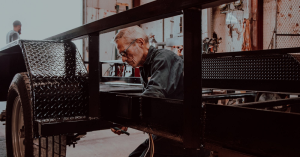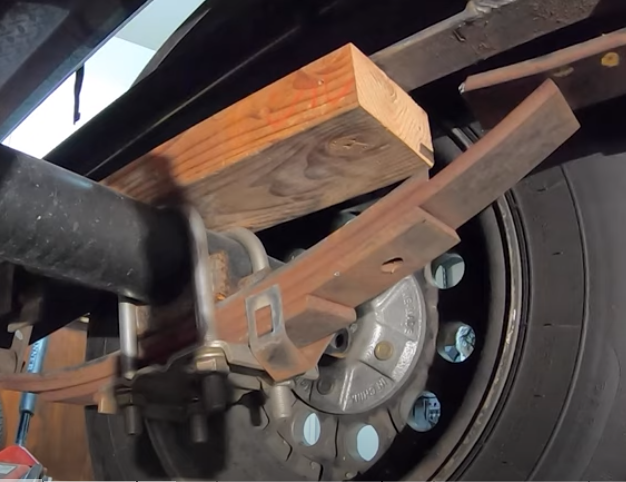
Leaf springs are an essential suspension component in many vehicles including trailers, trucks, vans and SUVs. As you know, leaf springs provide stability and shock absorption from uneven road surfaces. The materials used to manufacture leaf springs have a significant impact on their strength, durability and performance for these demanding applications.
This article will provide you with a comprehensive overview of leaf spring materials. It will cover the primary metals used, considerations for optimal material selection, properties of leaf spring steel, manufacturing processes, repair limitations, and comparisons to coil springs. The goal is to equip you with knowledge regarding appropriate materials and design factors in engineering durable, high-performing leaf springs.

Leaf Springs are commonly crafted from steel, but they can also utilize alternative materials such as titanium or composite plastics, although steel remains the primary choice due to its superior strength.
The grade of metal employed in Leaf Springs is not a one-size-fits-all concept. It varies depending on several factors, including the type of vehicle, its load capacity, and the manufacturer’s specifications.

The choice of steel grade is determined by various factors, including the necessary level of strength and performance, ensuring that Leaf Springs are tailored to the specific demands of their application.
High-Carbon Steel is The Ultimate Choice.High-carbon steel stands out as the prime candidate for crafting Leaf Springs. Its unmatched blend of strength, ductility, and fatigue resistance makes it the top pick. Furthermore, the incorporation of alloying elements like chromium and nickel can further enhance the steel’s properties, tailoring it to specific needs.
When evaluating materials for Leaf Springs, certain key factors you should take precedence:
1. High Yield Strength: The chosen material must exhibit exceptional yield strength, ensuring it can withstand the demanding loads and stresses experienced by Leaf Springs.
2. Durability Under Cyclic Loads: Leaf Springs are subjected to repetitive and varying stresses during their operational life. Hence, the selected material must exhibit excellent durability, resisting fatigue-induced failures over time.
3. Adequate Ductility: Ductility is crucial to prevent permanent deformation of the Leaf Springs when subjected to heavy loads. A suitable material should possess decent ductility to maintain its structural integrity.
Choosing the right material is pivotal in ensuring the Leaf Springs can perform their vital role effectively and reliably.

High Carbon Content: Yes, Leaf Spring steel is classified as high carbon steel, typically containing between 0.60% to 0.99% carbon content. This high carbon content is essential to achieve the specific properties required for Leaf Springs.
Strengthening Through Heat Treatment: The characteristics of Leaf Spring steel are further enhanced through heat treatment processes. Quenching and tempering, for instance, are employed to increase the steel’s strength and hardness. Quenching involves rapid cooling, while tempering involves controlled reheating. This combination of processes imparts the necessary toughness and rigidity to the steel, ensuring it can withstand heavy loads and constant flexing.
Enhanced Fatigue Resistance: Another critical aspect of Leaf Spring steel is its ability to withstand fatigue. Shot peening is a technique commonly used to improve the steel’s fatigue resistance. During shot peening, the surface of the steel is bombarded with tiny metal pellets or “shots,” inducing compressive stresses that counteract the tensile stresses experienced during use. This process contributes significantly to the durability and longevity of Leaf Springs.
Leaf spring manufacturing starts by cutting steel to size and heating it. Forming techniques shape the steel before it is quenched and tempered to add strength. Shot peening is used last to enhance durability.
Welding Leaf Springs is generally discouraged due to the potential to concentrate stresses at the weld points. It is usually recommended to replace damaged springs rather than attempting to weld them, as welding can compromise their structural integrity and performance.
Repairing cracked or broken Leaf Springs is also not recommended, as restoring the original strength to a sufficient level is nearly impossible. Replacement is the safer and more reliable option, ensuring the vehicle’s safety and performance.

When comparing Leaf Springs to Coil Springs in terms of strength:
Leaf Springs are known for their higher strength and stiffness. Their laminated steel construction resists bending and twisting effectively under heavy loads, making them ideal for supporting the weight of heavy vehicles.
Coil Springs, on the other hand, are more compliant and excel at shock absorption. They provide a smoother ride by absorbing and dissipating shocks and vibrations, making them suitable for various applications where comfort is a priority.
Leaf Springs are prized for their robustness and load-bearing capacity, while Coil Springs offer a more cushioned and comfortable ride, each serving specific needs in the automotive and industrial sectors.
As a designer or factory, using the appropriate materials is crucial when designing leaf springs for vehicle suspension systems. While high-carbon steel is the standard, other metals or composites may be suitable depending on requirements. Manufacturing processes like heat treatment optimize steel leaf springs for strength and fatigue resistance. Overall, proper material selection and processing results in durable, high-performing leaf springs for the most demanding automotive applications.
With 18 years of expertise, TOW-MAX is committed to meeting your trailer, agricultural machinery, and commercial vehicle parts needs, especially high-quality leaf spring wholesale. To inquire further or initiate procurement, please contact us:
Phone: +86-574-8786-2718
Email: [email protected]
We look forward to a long-term partnership, providing you with top-quality leaf springs, trailer parts, and professional support. Thank you for choosing TOW-MAX as your trusted supplier. We look forward to working with you!
Our trailer parts expert will answer your inquiries within 12 hours.

Tow-Max is a trusted supplier of trailer parts in China, known for its huge variety of products and one-stop services. We have been supplying customers from Australia, South America, the USA, and the Middle East. Our business partners are located in Sydney, Melbourne, Adelaide, Mexico City, Dubai, etc.
No.163-1, Shang yang Road, Dongqian Lake Industrial Zone, Ningbo, 315121, Zhejiang, China
+86-574-8786-2718
+86-574-8786-2717
sales(at)soaringtrailerparts.com
©Copyright 2020. Tow-Max. All rights reserved. Powered by MML.